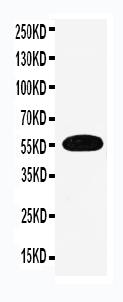Anti-EAAT3 Antibody
- SPECIFICATION
- CITATIONS
- PROTOCOLS
- BACKGROUND

Application
| WB |
|---|---|
| Primary Accession | P43005 |
| Host | Rabbit |
| Reactivity | Human |
| Clonality | Polyclonal |
| Format | Lyophilized |
| Description | Rabbit IgG polyclonal antibody for Excitatory amino acid transporter 3(SLC1A1) detection. Tested with WB in Human. |
| Reconstitution | Add 0.2ml of distilled water will yield a concentration of 500ug/ml. |
| Gene ID | 6505 |
|---|---|
| Other Names | Excitatory amino acid transporter 3, Excitatory amino-acid carrier 1, Neuronal and epithelial glutamate transporter, Sodium-dependent glutamate/aspartate transporter 3, Solute carrier family 1 member 1, SLC1A1, EAAC1, EAAT3 |
| Calculated MW | 57100 MW KDa |
| Application Details | Western blot, 0.1-0.5 µg/ml, Human |
| Subcellular Localization | Cell membrane ; Multi-pass membrane protein. Apical cell membrane ; Multi-pass membrane protein. Membrane; Multi-pass membrane protein. |
| Tissue Specificity | Expressed in all tissues tested including liver, muscle, testis, ovary, retinoblastoma cell line, neurons and brain (in which there was dense expression in substantia nigra, red nucleus, hippocampus and in cerebral cortical layers). . |
| Protein Name | Excitatory amino acid transporter 3 |
| Contents | Each vial contains 5mg BSA, 0.9mg NaCl, 0.2mg Na2HPO4, 0.05mg Thimerosal, 0.05mg NaN3. |
| Immunogen | A synthetic peptide corresponding to a sequence at the N-terminus of human EAAT3(10-27aa EWKRFLKNNWVLLSTVAA). |
| Purification | Immunogen affinity purified. |
| Cross Reactivity | No cross reactivity with other proteins |
| Storage | At -20˚C for one year. After r˚Constitution, at 4˚C for one month. It˚Can also be aliquotted and stored frozen at -20˚C for a longer time.Avoid repeated freezing and thawing. |
| Name | SLC1A1 (HGNC:10939) |
|---|---|
| Function | Sodium-dependent, high-affinity amino acid transporter that mediates the uptake of L-glutamate and also L-aspartate and D-aspartate (PubMed:21123949, PubMed:26690923, PubMed:33658209, PubMed:7521911, PubMed:7914198, PubMed:8857541). Can also transport L-cysteine (PubMed:21123949). Functions as a symporter that transports one amino acid molecule together with two or three Na(+) ions and one proton, in parallel with the counter-transport of one K(+) ion (PubMed:26690923, PubMed:33658209, PubMed:7521911, PubMed:8857541). Mediates Cl(-) flux that is not coupled to amino acid transport; this avoids the accumulation of negative charges due to aspartate and Na(+) symport (PubMed:26690923, PubMed:8857541). Plays an important role in L- glutamate and L-aspartate reabsorption in renal tubuli (PubMed:21123949). Plays a redundant role in the rapid removal of released glutamate from the synaptic cleft, which is essential for terminating the postsynaptic action of glutamate (By similarity). Contributes to glutathione biosynthesis and protection against oxidative stress via its role in L-glutamate and L-cysteine transport (By similarity). Negatively regulated by ARL6IP5 (By similarity). |
| Cellular Location | Cell membrane; Multi-pass membrane protein {ECO:0000250|UniProtKB:P43003}. Apical cell membrane; Multi-pass membrane protein {ECO:0000250|UniProtKB:P43003}. Synapse, synaptosome {ECO:0000250|UniProtKB:P51906}. Early endosome membrane {ECO:0000250|UniProtKB:P51906}. Late endosome membrane {ECO:0000250|UniProtKB:P51906}. Recycling endosome membrane {ECO:0000250|UniProtKB:P51906} |
| Tissue Location | Expressed in all tissues tested including liver, muscle, testis, ovary, retinoblastoma cell line, neurons and brain (in which there was dense expression in substantia nigra, red nucleus, hippocampus and in cerebral cortical layers) |

Thousands of laboratories across the world have published research that depended on the performance of antibodies from Abcepta to advance their research. Check out links to articles that cite our products in major peer-reviewed journals, organized by research category.
info@abcepta.com, and receive a free "I Love Antibodies" mug.
Provided below are standard protocols that you may find useful for product applications.
Background
Solute carrier family 1 member 1, also called SLC1A1, is a protein that in humans is encoded by the SLC1A1 gene. By Southern analysis of a panel of human/rodent somatic cell hybrids and by fluorescence in situ hybridization(FISH), this gene is mapped to 9p24.2. This gene encodes a member of the high-affinity glutamate transporters that play an essential role in transporting glutamate across plasma membranes. In brain, these transporters are crucial in terminating the postsynaptic action of the neurotransmitter glutamate, and in maintaining extracellular glutamate concentrations below neurotoxic levels. This transporter also transports aspartate, and mutations in this gene are though to cause dicarboxylicamino aciduria, also known as glutamate-aspartate transport defect.
If you have used an Abcepta product and would like to share how it has performed, please click on the "Submit Review" button and provide the requested information. Our staff will examine and post your review and contact you if needed.
If you have any additional inquiries please email technical services at tech@abcepta.com.













 Foundational characteristics of cancer include proliferation, angiogenesis, migration, evasion of apoptosis, and cellular immortality. Find key markers for these cellular processes and antibodies to detect them.
Foundational characteristics of cancer include proliferation, angiogenesis, migration, evasion of apoptosis, and cellular immortality. Find key markers for these cellular processes and antibodies to detect them. The SUMOplot™ Analysis Program predicts and scores sumoylation sites in your protein. SUMOylation is a post-translational modification involved in various cellular processes, such as nuclear-cytosolic transport, transcriptional regulation, apoptosis, protein stability, response to stress, and progression through the cell cycle.
The SUMOplot™ Analysis Program predicts and scores sumoylation sites in your protein. SUMOylation is a post-translational modification involved in various cellular processes, such as nuclear-cytosolic transport, transcriptional regulation, apoptosis, protein stability, response to stress, and progression through the cell cycle. The Autophagy Receptor Motif Plotter predicts and scores autophagy receptor binding sites in your protein. Identifying proteins connected to this pathway is critical to understanding the role of autophagy in physiological as well as pathological processes such as development, differentiation, neurodegenerative diseases, stress, infection, and cancer.
The Autophagy Receptor Motif Plotter predicts and scores autophagy receptor binding sites in your protein. Identifying proteins connected to this pathway is critical to understanding the role of autophagy in physiological as well as pathological processes such as development, differentiation, neurodegenerative diseases, stress, infection, and cancer.


